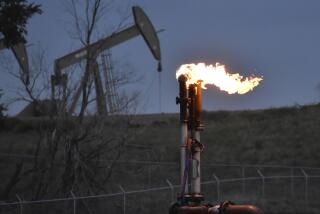Winds carry Asian smog component to Western U.S., study finds
- Share via
Ozone from Asia is wafting across the Pacific on springtime winds and boosting the amount of the smog-producing gas found in the skies above the Western United States, researchers said in a study released Wednesday.
The study, published in the journal Nature, looks at a phenomenon that has puzzled scientists in the last decade: Ground-level ozone has dropped in cities thanks to tighter pollution controls; but it has risen in rural areas in the Western U.S., where there is little industry or automobile traffic.
The study, led by Owen R. Cooper, an atmospheric scientist at the University of Colorado, examined nearly 100,000 observations two to five miles above ground -- in a region known as the free troposphere -- gathered from aircraft, balloons and ground-based lasers.
It found that baseline ozone -- the amount of gas not produced by local vehicles and industries -- has increased in springtime months by 29% since 1984.
The study has important implications both for the curbing of conventional pollution that damages human health and for controlling greenhouse gases that are changing the planet’s climate, experts said.
It shows the need for a transformation of global energy and transportation systems, said Mary Nichols, chairwoman of the California Air Resources Board.
“Atmospheric scientists keep finding more evidence that pollutants travel around the globe and move up and down as they travel,” she said. “There is not a bright line separating greenhouse gases from regular air pollution.”
The study, co-written by researchers from nine institutes in the U.S. and abroad, is only a first step in understanding cross-border pollution, Cooper said. More research will be needed to investigate how much of the ozone from the troposphere reaches the ground and how much flows across borders at other times of the year. The researchers began with the free troposphere because it is easier to eliminate local sources from baseline ozone calculations.
They chose April and May because that is when winds from Asia are strongest.
“Ozone is a difficult gas to pin down,” said Cooper, who works at the Earth System Research Laboratory of the National Oceanic and Atmospheric Administration in Boulder, Colo. “The study of intercontinental air pollution has been going on for a decade, but whether it was increasing overall was uncertain.
“And in places where it had spiked, along coasts and in national parks, we didn’t know how much was from local sources and how much was from Asia.”
Cooper said scientists had not determined how much of the ozone increase comes from Asia, but they found that the increase was about twice as much when prevailing winds came from South and East Asia. (Emissions of nitrogen oxides, a key ingredient for ozone formation, have increased more than 50% in China over the last decade while decreasing in the U.S. and Europe.)
Still, the study offers “the most conclusive evidence so far of increasing ozone levels in the free troposphere over North America,” wrote atmospheric chemist Kathy Law, an expert in long-range pollution transport, in a Nature commentary on the paper.
Moreover, she added, the increases “certainly have implications for climate change, causing warming either at the mid-latitudes where ozone forms, or in sensitive regions such as the Arctic to which ozone might be transported.”
According to the Environmental Protection Agency, ground-level ozone is linked to serious health problems, including aggravation of asthma and increased risk of premature death in people with heart or lung disease.
In Southern California, which has some of the highest pollution levels in the U.S., smog levels exceed health standards more than 80 days a year. Based on new studies, the EPA announced this month that it may tighten federal ozone rules.
margot.roosevelt@ latimes.com







